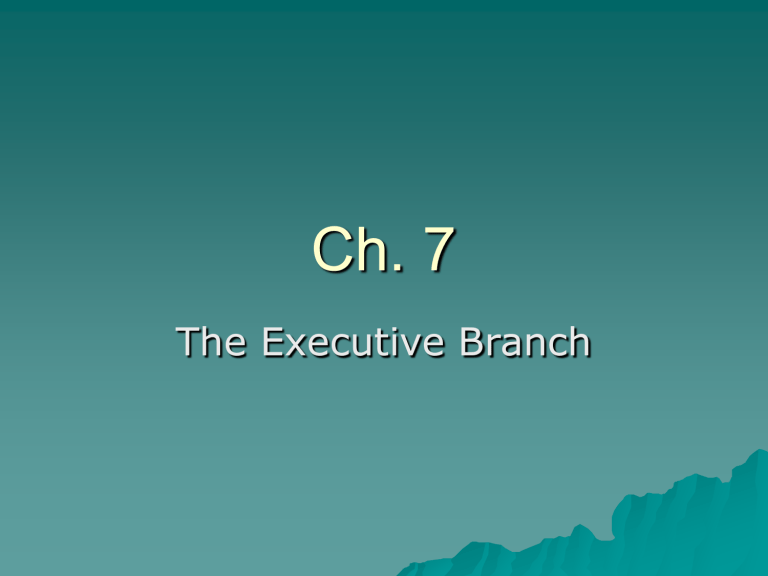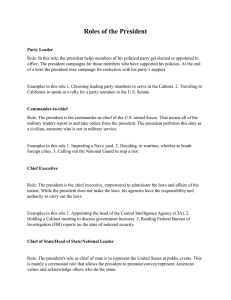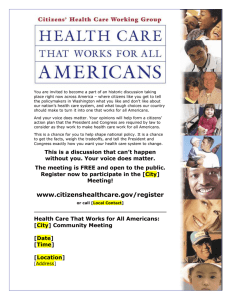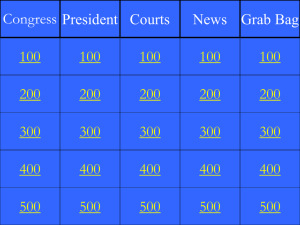Ch. 7 The Executive Branch

Ch. 7
The Executive Branch
The President’s Job: Ch. 7.2
The President’s main job is to carry out the laws passed by Congress.
The Constitution gives the president power to veto, call Congress into special session, serve as commander-in-chief, and receive foreign officials.
The president can also make treaties, appoint judges and top government officials, and pardon convicted criminals
Jobs of the President
The Constitution also requires the president to give Congress an update of the nation with the “State of the
Union” address.
The president discusses the most important issues facing the nation and describes new legislation he would liked passed.
7 Roles of the President
1.
2.
3.
4.
5.
6.
7.
Chief Executive
Chief Diplomat
Commander-in-Chief
Chief Legislator
Head of State
Economic Leader
Party Leader
Chief Executive
As Chief Executive, the president is in charge of 15 cabinet departments and more than 3 million government workers.
The president appoints the heads of cabinet departments and large agencies
(Senate must approve)
Ex. Dept. of Defense, State Dept., Dept. of
Treasury
Chief Executive
The president does not have any legislative powers (can not make laws), but he can issue executive orders—rules or commands that have the force of law.
Can be good for the nation—Ex. Order
9981 (1948) desegregates military
Can be detrimental to the country—Ex.
Order 9066 (1942) Japanese American
Internment camps
Chief Executive
The president can appoint federal judges, including Supreme Court justices.
This is important because the way the Supreme
Court interprets laws greatly affects life in the
U.S.
Most presidents will appoint justices who share views similar to their own
Influence will be felt long after they leave the
White House
Chief Executive
Besides the power of appointment, the president does have some judicial powers.
The president can grant pardons, or declarations of forgiveness and freedom from punishment
The president can also issue a reprieve, an order to delay a person’s punishment until a higher court can hear the case.
Can also grant amnesty, a pardon toward a group of people.
Chief Diplomat
The president is responsible for directing foreign policy, or the country’s strategy on how we deal with foreign nations and the relationships we build
Directs the U.S. in making key decisions about how we conduct ourselves in the world
Commander-in-Chief
As commander-in-chief, the president is in charge of all branches of the armed forces.
Congress and the president share the power to make war. Only
Congress can declare war, but only the president can order soldiers into battle.
Commander-in-Chief
Congress has declared war only 5 times, yet presidents have sent troops into action over 150 times.
Can potentially threaten the system of checks and balances
After the undeclared Vietnam War, Congress passed the
War Powers Act. This law requires the president to notify
Congress immediately when troops are sent into battle.
The troops must be brought home after 60 days unless
Congress approves a longer stay or declares war.
Chief Legislator
Only Congress may introduce bills, but the executive branch proposes most legislation.
All presidents have a legislative program that they want Congress to pass.
The speeches they give to key members of
Congress and the public is done so to build support for their programs.
The presidents’ staff works on the laws with members of Congress. Ex. Patriot Act or tax cuts
Chief Legislator
The president and Congress often disagree.
A main reason for that the president represents the whole nation. Congress members only represent their states or districts
Another reason is that the president can only serve two terms. Many Congress members win reelection many times and remain in office sometimes for decades.
As a result, the president often wants to move faster on programs than members of Congress do. (Status Quo v.
Change)
Head of State
The president is the living symbol of the U.S.
As head of state, the president is responsible for hosting visiting foreign leaders and carrying out ceremonial functions. Ex. Awarding medals or throwing out the first pitch at a baseball game.
Economic Leader
As a country’s economic leader, it is the presidents’ job to ensure that the economy is prospering.
The president must plan the federal budget and try to deal with problems such as unemployment, rising prices
(inflation), and high taxation.
Party Leader
The president is the face of his or her political party.
Members of the political party work hard to elect the president into office.
In return, the president gives speeches to raise campaign money and help fellow party members win political office in the
Senate, House, and Governor’s seats.
Making Foreign Policy: Ch. 7.3
Foreign policy is a nations’ overall plan for dealing with other nations.
There are many goals our country tries to achieve:
1.
2.
3.
4.
National Security
International Trade
Promotion of World Peace
Promotion of Human Rights and
Democracy
Foreign Policy Bureaucracy
The Executive Branch includes a large foreign policy bureaucracy.
It includes:
- State Department
- Department of Defense
- Central Intelligence Agency
- National Security Council (NSC)
Congress v. the President
The president and Congress share the power to conduct foreign affairs.
The president is the chief diplomat and commander-in-chief, but
Congress has the power to declare war, prohibit certain military actions, and spend or withhold money for defense.
Congress v. the President
The Constitution does not make clear how the executive and legislative branches can use their powers.
Because of this, the branches compete for control of foreign policy.
Tools of Foreign Policy
Treaties and Executive Agreements
Treaties are formal agreements between the governments of two or more countries.
Some treaties, such as NATO (April 1949), are agreements among nations for mutual defense; NAFTA was made as an economic free trade agreement.
The Senate must approve a treaty by a 2/3 vote.
President can however make an executive agreement with the leader of another country without Senate approval.
Deal with routine matters
Tools of Foreign Policy
Appointing Ambassadors
An ambassador is an official representative of a country’s government.
The president appoints ambassadors, with
Senate approval.
Ambassadors are only sent to countries where the U.S. accepts the government as legally in power.
Tools of Foreign Policy
Foreign Aid
The U.S. gives foreign aid in the form of money, food, military assistance, or other supplies to help other countries.
Ex. The Marshall Plan 1947-1951 which helped rebuild Western Europe after World War II. $13 Billion total.
Tools of Foreign Policy
International Trade
The president makes agreements with other nations about what products may be traded and the rules of trade.
Sometimes the rules include trade sanctions – efforts to punish another country by imposing trade barriers.
Another punishing tool is an embargo, an agreement among a group of nations that prohibits them all from trading with the target nation.
Tools of Foreign Policy
Congress takes the lead in imposing tariffs on imported goods and in joining international trade groups
One such trade group is the North
American Free Trade Agreement
(NAFTA)
Tools of Foreign Policy
Military Force
As commander-in chief, presidents may use the military to carry out some foreign policy decisions that could involve deploying armed forces or launching missile attacks.
Powerful tool, but must be used with care.
Ex. Iraq and Afghanistan; Vietnam
Ch. 7.4: Executive Office of the
President
The Executive Office of the President
(EOP) was created in 1939 by FDR.
Assists the President in doing his job
Includes over 2000 employees and $100 million budget
Prepares reports, drafts bills, checks the work of various executive agencies
White House Staff
Consists of 500 people/10-12 closest advisors to the President
Most powerful person Chief of Staff: screens the flow of information and people to the President
Press Secretary: deals with the media on behalf of the President. Updates press on the President’s position on various issues.
Office of Management and Budget
(OMB)
Prepares the federal budget and helps the President monitor government spending
Federal budget lays out the administrations plans and goals for the upcoming year
National Security Council (NSC)
Helps President coordinate the military and construct foreign policy.
Includes the V.P., Sec. of State, Sec. of
Defense, Chairman of the Joint Chiefs of
Staff, and top commanders of each of the armed forces.
Forms our nations foreign policies and principles of the U.S. Supervises the CIA.
Council of Economic Advisers
(CEA)
Contains three independent members or economists
Advise the President about economic matters: employment in the U.S., tax policy, inflation, trade with other countries, etc.
President’s Cabinet Depts
These are the advisers who are the heads of the 15 top level executive depts. (state, treasury, justice, defense)
Head of the Dept. of Justice is the
Attorney General. All other heads will have the title of secretary.
Department Heads
Must be approved by the Senate
Any advise given to the President will usually be on issues related to their departments
President will determine when they meet and how much to rely on their advise.
The Federal Bureaucracy
The Executive Branch is shaped like a triangle.
Top down: President depts hundreds of executive agencies
The Federal Bureaucracy (cont.)
1.
Departments and agencies carry out government programs in 3 ways:
Develop procedures for putting new laws into practice
2.
3.
Administer day-to-day operations of government
Regulate or police various governmental activities
This all helps shape government policy
Independent agencies
Not a part of any cabinet, but still have to report out to the President
3 types: Executive Agencies
Government Corporations
Regulatory Commissions
Executive Agencies
Deal with specialized areas of expertise
Ex. NASA, FED, NSA, FDA, EPA
Government Corporations
Act like private businesses but government owns and runs them.
They charge for services, but are not supposed to make a profit, all $ go back into the business
Ex. U.S. postal service
Regulatory Commissions
DOES NOT REPORT TO THE PRESIDENT
President appoints the head of regulatory commissions but only Congress can remove (impeach)
Protects the public by making and enforcing rules for certain industries
Ex. FCC, FAA
Political Appointees
Top department jobs usually go to political appointees
Employment usually ends when the
President leaves office
90% of national government employees are civil service workers
Political Appointees
Usually have permanent employment
Hiring is usually based on open, competitive examinations and merit.
Before 1883, hiring was based on
“who you knew”
Spoils system
Abuse of the spoils system led to
Congress passing the Pendleton Act or Civil Service Reform Act of 1883.
This established the Office of
Personnel Management






